 |
|
 |
Explore Saturn's Moon Enceladus
Until recently, Saturn's tiny moon Enceladus was thought to be cold and dead. But close observations by the Cassini spacecraft have revealed dramatic features and has sparked new widespread interest in this frozen world, making it a prime target in NASA's search for life. Uncover the many unique features of Enceladus and watch the story unfold.
Launch Enceladus Explorer |
|
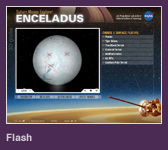 |
 |
The Best of NASA Science 2007: A Year in Review
Go back in time through the year 2007 to view the stunning images of wondrous science highlights of NASA. From the discovery of organic materials in a rare meteorite, to advances in studying the changes in Earth's ever-changing climate, this interactive slide show takes you on a spin through an incredible year. It's an incredible journey.
Launch Image Viewer |
|
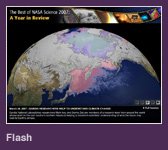 |
 |
Explore Saturn's Moon Titan
Mysterious Titan begins to appear more familiar as the Cassini spacecraft explores the once hidden surface of this Earth-like moon.
Launch Titan Explorer |
|
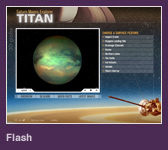 |
 |
The Best of NASA Science 2006: A Year in Review
Come and tour the month by month science highlights of NASA in 2006. From the Earth re-entry of the Stardust capsule to the discoveries found on Saturn and its rings and moons, to more evidence of water on Mars, 2006 was another exciting year in solar system exploration. Click now to start the slideshow - you won't be disappointed.
Launch Image Viewer
|
|
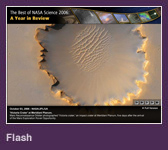 |
 |
Ion Engines
Ion Engines are the most exciting new rocket propulsion system since the Chinese invented the rocket about a thousand years ago. These activities should help you understand how Ion Engines work. Play the first three activities to learn the basics about electric charges. The final activity lets you test your knowledge and skills in operating an ion engine.
Launch Ion Engines |
|
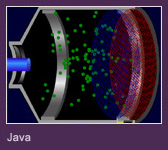 |
 |
The Best of NASA Science 2005: A Year in Review
2005 was a very exciting year for science discoveries at NASA. From landing on Saturn's moon Titan to discovering life components in a far off, young universe, take a journey with images and learn all about the exciting exploration discoveries of 2005. Combined with the accomplishments of missions such as Deep Impact and the launch of the Mars Reconnaissance Orbiter, 2005 offered a rich landscape from which to advance exploration into the next several decades, and beyond.
Launch Image Viewer |
|
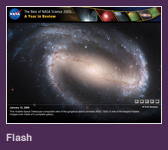 |
 |
The Planetary Explorer
Which world is the windiest in our solar system? How about the hottest? What does comet Halley have in common with New York City? The answers may surprise you. Pick a planet and find out what it is all about, what it looks like and how it stacks up against all the other worlds in our solar system.
Launch Planetary Explorer |
|
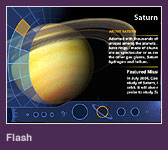 |
 |
Timeline: The Robotic Exploration of Space
Neil Armstrong and Buzz Aldrin were the first humans to walk on the Moon, but it was robots who paved the way. Take a journey through decades of triumph - and frustration - and scientists and engineers found ways to extend humanity's vision beyond Earth. Come back often. This story is far from over and we'll be adding history as it happens.
Launch Timeline |
|
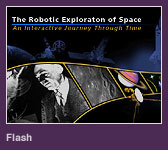 |
 |
NASA Solar System Launches & Events Calendar
Tune in to history as it happens. Our interactive calendar showcases what's happening out there in the solar system and back here on Earth. We've included launches, mission events, anniversaries, celestial events and even a few birthdays. There's never a dull moment in space.
Launch Calendar |
|
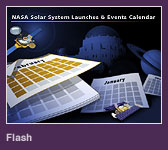 |
 |
Celestial Selection
Vote early and often for your favorite solar system exploration images in our multimedia gallery. Choose any category (planets, history, spacecraft, kid's drawings, etc.) and click on the "browse" button. The voting menu is that row of five stars under each image. Vote all you like and watch as everyone's favorite images work their way to the top.
See Our Top 10 Images |
|
 |